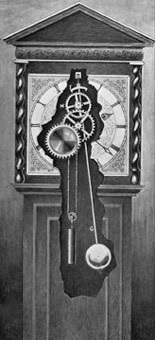Pendulum Clocks

 |
In 1656, Christiaan Huygens, a Dutch scientist, made the first pendulum clock, regulated by a mechanism with a “natural” period of oscillation. Although Galileo Galilei, sometimes credited with inventing the pendulum, studied its motion as early as 1582, Galileo's design for a clock was not built before his death. Huygens' pendulum clock had an error of less than 1 minute a day, the first time such accuracy had been achieved. His later refinements reduced his clock's errors to less than 10 seconds a day.
Refinements led in 1889 to Siegmund Riefler's clock with a nearly free pendulum, which had an accuracy of a hundredth of a second a day. A true free-pendulum was introduced by R. J. Rudd about 1898, stimulating development of several free-pendulum clocks.
One of the most famous, the Shortt clock, was demonstrated in 1921. The Shortt clock replaced Riefler's clock as a supreme timekeeper. This clock consists of two pendulums, one a slave and the other a master. The slave pendulum gives the master pendulum the gentle pushes needed to maintain its motion, and drives the clock's hands. This allows the master pendulum to remain free from tasks that would disturb its regularity.







